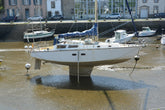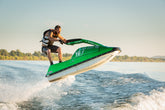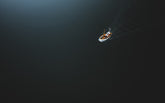The keel of a boat is a structural component that extends vertically down from the bottom of the hull. It serves as the backbone of the vessel, providing essential functions for stability, performance, and control. Understanding the role and significance of the keel is crucial for any boat owner or enthusiast.
The keel can be described as the fin-like structure that protrudes from the bottom of the hull, running along the centerline of the boat. It is typically made of sturdy materials, such as cast iron, lead, or a combination of materials, to provide the necessary weight and strength.
In addition to its structural importance, the keel also plays a vital role in the overall design and performance of the boat. It contributes to the vessel's handling characteristics, resistance to leeway (sideways drift), and overall efficiency in the water.
The importance of a keel in a boat
The keel is an indispensable part of a boat's design, serving several critical functions:
- Stability: The keel's weight and positioning low in the hull help to counterbalance the force of the wind on the sails or the boat's motion, preventing excessive heeling (leaning) or capsizing.
- Tracking: The keel acts as a underwater "rudder," helping the boat track straight and resist sideways slippage, especially when sailing into the wind or in strong currents.
- Efficiency: By providing lateral resistance, the keel allows the boat to sail more efficiently and maintain a desired course with minimal correction from the rudder.
- Structural Integrity: The keel serves as a strong backbone for the hull, distributing the forces and stresses experienced by the boat during operation and in rough conditions.
Without a properly designed and constructed keel, a boat would be unstable, difficult to control, and prone to drifting or capsizing, especially in challenging weather conditions.
Different types of boat keels
Boat keels come in various shapes and designs, each tailored to specific boat types and sailing requirements. Here are some of the most common types:
- Full Keel: A full keel runs the entire length of the hull, providing maximum lateral resistance and directional stability. This design is often found on traditional cruising sailboats and displacement hulls.
- Fin Keel: A fin keel is a more modern design that features a narrow, blade-like keel attached to the bottom of the hull. This design offers improved performance and maneuverability compared to a full keel, while still providing sufficient stability.
- Wing Keel: A wing keel is a variation of the fin keel, with a broader, wing-like shape that extends further aft. This design offers increased lateral resistance and stability, making it suitable for high-performance sailing vessels.
- Bulb Keel: A bulb keel features a streamlined fin with a bulbous weight at the bottom, which lowers the center of gravity and enhances stability. This design is commonly found on modern racing and cruising yachts.
- Centerboard/Daggerboard: Some boats, particularly smaller day sailors or coastal cruisers, employ a retractable centerboard or daggerboard instead of a fixed keel. This design allows for shallow-water operation and easier trailering or storage.
The choice of keel type depends on factors such as the boat's intended use, performance requirements, and the desired balance between stability, maneuverability, and speed.
How does a keel function?
The keel's primary function is to provide lateral resistance and counterbalance the forces acting on the boat, particularly when sailing into the wind or in strong currents. Here's how it works:
- Lateral Resistance: The keel's underwater surface area creates resistance against sideways motion, known as leeway. This resistance helps the boat track straight and maintain its desired course, minimizing the need for constant rudder correction.
- Counterbalancing: The weight of the keel, concentrated low in the hull, acts as a counterbalance to the force of the wind on the sails or the boat's motion. This prevents excessive heeling (leaning) or capsizing, ensuring the boat remains upright and stable.
- Directional Stability: The keel's shape and positioning contribute to the boat's directional stability, helping it stay on course and resist veering off track due to wind shifts or currents.
- Structural Support: As the backbone of the hull, the keel distributes the loads and stresses experienced by the boat during operation, such as the forces exerted by waves, wind, and the weight of the boat itself.
The keel's effectiveness in fulfilling these functions depends on its size, shape, weight distribution, and positioning relative to the hull's center of buoyancy and center of effort (the points where the buoyant and wind forces act, respectively).
The role of a keel in stability and performance
The keel plays a crucial role in both the stability and performance of a boat:
Stability
The keel's weight and low positioning contribute to a lower center of gravity, increasing the boat's righting moment and resistance to heeling or capsizing.
A deeper keel provides more leverage against the force of the wind, further enhancing stability.
Performance
The keel's lateral resistance reduces leeway, allowing the boat to sail closer to the true wind direction and maintain a more efficient course.
A well-designed keel can improve the boat's tracking ability, reducing the need for constant rudder adjustments and increasing overall efficiency.
In some cases, a deeper or more streamlined keel can contribute to higher speeds by reducing drag and enhancing hydrodynamic efficiency.
Finding the right balance between stability and performance is a key consideration in keel design, as these two factors often involve trade-offs. For example, a deeper keel may provide excellent stability but can also increase drag and reduce maneuverability in tight spaces or shallow waters.
Keel design considerations
When designing or selecting a keel for a boat, several factors must be taken into account:
- Boat Type and Intended Use: The keel design should align with the boat's intended purpose, such as coastal cruising, offshore sailing, racing, or day sailing.
- Hull Design: The keel's shape, size, and positioning must complement the hull's design, ensuring proper weight distribution, balance, and hydrodynamic efficiency.
- Stability Requirements: The keel's weight and vertical projection should provide sufficient righting moment and stability for the boat's size, displacement, and sail plan.
- Performance Goals: For boats prioritizing speed and maneuverability, a more streamlined or high-aspect ratio keel may be preferred, while cruising boats may favor a design that emphasizes stability and tracking ability.
- Draft Limitations: The keel's draft (depth below the waterline) must be considered, especially for boats intended for shallow waters or areas with depth restrictions.
- Construction Materials: The choice of materials, such as lead, cast iron, or composite materials, affects the keel's weight, durability, and maintenance requirements.
- Regulatory Compliance: Keel designs must adhere to relevant safety standards and regulations, particularly for offshore or ocean-going vessels.
Experienced naval architects and boat designers carefully analyze these factors to create a keel design that optimizes the boat's performance, stability, and seaworthiness while meeting the specific requirements of the vessel and its intended use.
Maintenance and care for boat keels
Proper maintenance and care are essential to ensure the longevity and optimal performance of a boat's keel. Here are some important considerations:
- Inspection: Regularly inspect the keel for any signs of damage, cracks, or corrosion, especially after grounding or impact incidents. Pay attention to the keel-hull joint and any visible bolts or fasteners.
- Antifouling: Apply appropriate antifouling coatings to the keel to prevent the buildup of marine growth, which can increase drag and reduce efficiency.
- Grounding Protection: Install keel guards or sacrificial strips to protect the keel from damage if the boat runs aground or encounters underwater obstacles.
- Galvanic Corrosion: If the keel is made of a dissimilar metal from the hull, ensure proper insulation and bonding to prevent galvanic corrosion.
- Ballast Maintenance: For ballasted keels, periodically check the integrity of the ballast material and encapsulation to prevent water intrusion or shifting of the ballast.
- Repairs: Address any keel damage or issues promptly to maintain structural integrity and prevent further deterioration.
- Professional Inspections: Consider having the keel inspected by a qualified marine surveyor or boatyard during regular maintenance intervals or after any significant incidents.
Neglecting keel maintenance can lead to performance issues, increased drag, and potentially compromised safety. Regular care and attention to the keel will help ensure your boat's stability, efficiency, and longevity on the water.
Common misconceptions about boat keels
Despite the crucial role of the keel, there are several common misconceptions surrounding this essential component:
- "The keel is just for stability." While stability is a primary function, the keel also contributes to tracking, lateral resistance, and overall performance.
- "A deeper keel is always better." While a deeper keel can improve stability, it may also increase draft, reduce maneuverability, and impact performance in certain conditions.
- "Keel design doesn't matter for small boats." Even on smaller vessels, the keel's design can significantly affect handling, efficiency, and overall sailing experience.
- "All keels are created equal." Different keel types (full, fin, wing, etc.) have distinct characteristics and are tailored for specific boat designs and sailing requirements.
- "Keel maintenance is unnecessary." Neglecting keel maintenance can lead to structural issues, increased drag, and potential safety hazards.
Understanding the true functions and importance of the keel can help boat owners and sailors make informed decisions about their vessel's design, maintenance, and performance.
The evolution of boat keel designs
Keel designs have undergone significant evolution throughout the history of sailing, driven by advancements in materials, engineering, and changing performance demands:
- Early Designs: Early sailing vessels, such as the Viking longships and medieval cogs, featured simple, full-length keels that provided stability and tracking ability.
- Ballasted Keels: The introduction of ballasted keels in the 19th century allowed for deeper, more efficient keel designs while maintaining stability and righting moment.
- Fin Keels: The fin keel, pioneered in the early 20th century, offered improved hydrodynamics and maneuverability, paving the way for modern racing and performance sailing.
- Wing Keels: The wing keel design, developed in the latter half of the 20th century, further enhanced lateral resistance and stability for high-performance sailing vessels.
- Bulb Keels: The addition of a bulbous weight at the bottom of the keel lowered the center of gravity and improved stability, particularly for offshore racing yachts.
- Canting Keels: Canting keels, which can be rotated to optimize the keel's angle of attack, emerged as a cutting-edge technology for high-end racing yachts, maximizing performance in different wind conditions.
- Composite Materials: The use of advanced composite materials, such as carbon fiber and high-strength resins, has enabled the construction of lighter, stronger, and more efficient keel designs.
This ongoing evolution reflects the constant pursuit of improved performance, stability, and efficiency in sailing, driven by technological advancements and the ever-increasing demands of competitive racing and long-distance cruising.
Conclusion
The keel is an essential component of a boat's design, playing a vital role in stability, tracking, lateral resistance, and overall performance. Understanding the importance and functions of the keel is crucial for boat owners, sailors, and enthusiasts alike.
From providing counterbalance against wind and wave forces to contributing to directional stability and efficiency, the keel is the backbone of a vessel's seaworthiness. Its design, size, and positioning are carefully considered by naval architects and boat designers to optimize performance while meeting the specific requirements of the intended use.


![Veratron OL 43 Smart Marine Monitoring TFT Display [B00126101]](http://arcmarine.co/cdn/shop/files/111172XL_165x.jpg?v=1763678982)
![Veratron Suzuki VMH-35 PWM Display w/Sumitomo Connectors [B00204101]](http://arcmarine.co/cdn/shop/files/111170XL_165x.jpg?v=1763678982)



